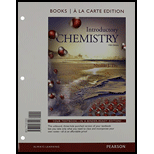
Interpretation:
The given table is to be completed by determining the formula, type (ionic, molecular or acid) and name of the given compound.
Concept Introduction:
Compounds which are formed between the metals and non-metals are ionic compounds.
The naming of ionic compounds which contains a metal forming only one type of ion is as follows:
The compounds which are composed of non-metals are known as molecular compounds. The molecular compounds are named by writing the name of first element with the prefix. This is followed by the prefix of second element and suffix ‘-ide’ is placed on the end of the name of second element. The prefixes are written to indicate the number of atoms present in the compound.
Oxyacids are the combination of one or more hydrogen ions with an oxyanion. The naming of these acids depends on the ending of the oxyanion. The naming of oxyacids ending with –ate is as follows:
First, base name of oxyanion is written followed by the suffix –ic to it and then, the word acid follows it.
Want to see the full answer?
Check out a sample textbook solution
Chapter 5 Solutions
Introductory Chemistry, Books a la Carte Edition & Modified MasteringChemistry with Pearson eText -- ValuePack Access Card -- for Introductory Chemistry Package
- For each of the following samples of ionic substances, calculate the number of moles and mass of the positive ions present in each sample. l type="a"> 4.25 g of ammonium iodide, NH4I i>6.31 moles of ammonium sulfide, ( NH4)2S i>9.71 g of barium phosphide, Ba3P2 i>7.63 moles of calcium phosphate, Ca3( PO4)2arrow_forwardComplete the following table. l> Mass of Sample Moles of Sample Atoms in Sample 5.00 g AI td> 0.00250 mol Fe td> msp;2.61024 atoms Cu 0.00250 g Mg td> msp;2.7103 mol Na msp;1.00104 atoms Uarrow_forwardYou have a pure sample of the antiseptic aminacrine, C13H10N2. Calculate the mass in grams of 0.06500 mol aminacrine. Calculate the number of aminacrine molecules in a 0.2480-g sample. Calculate the number of nitrogen atoms in this 0.2480-g sample. Calculate the mass of N in 100. g aminacrine.arrow_forward
- Gypsum is hydrated calcium sulfate. A 4.89-g sample of this hydrate was heated. After the water was removed, 3.87 g anhydrous calcium sulfate remained. Determine the formula for this hydrate and name the compound.arrow_forwardZinc phosphate is used as a dental cement. A 50.00-mg sample is broken down into its constituent elements and gives 16.58 mg oxygen, 8.02 mg phosphorus, and 25.40 mg zinc. Determine the empirical formula of zinc phosphate.arrow_forwardUsing the average atomic masses given inside the front cover of this book, calculate the number of atoms present in each of the following samples. l type='a'> 1.50 g of silver, Ag 0.0015 moIe of copper, Cu 0.0015 g of copper, Cu 2.00 kg of magnesium, Mg 2.34 oz of calcium, Ca 2.34 g of calcium, Ca 2.34 moles of calcium, Caarrow_forward
 World of Chemistry, 3rd editionChemistryISBN:9781133109655Author:Steven S. Zumdahl, Susan L. Zumdahl, Donald J. DeCostePublisher:Brooks / Cole / Cengage Learning
World of Chemistry, 3rd editionChemistryISBN:9781133109655Author:Steven S. Zumdahl, Susan L. Zumdahl, Donald J. DeCostePublisher:Brooks / Cole / Cengage Learning Chemistry: The Molecular ScienceChemistryISBN:9781285199047Author:John W. Moore, Conrad L. StanitskiPublisher:Cengage Learning
Chemistry: The Molecular ScienceChemistryISBN:9781285199047Author:John W. Moore, Conrad L. StanitskiPublisher:Cengage Learning Introductory Chemistry: A FoundationChemistryISBN:9781337399425Author:Steven S. Zumdahl, Donald J. DeCostePublisher:Cengage Learning
Introductory Chemistry: A FoundationChemistryISBN:9781337399425Author:Steven S. Zumdahl, Donald J. DeCostePublisher:Cengage Learning Introductory Chemistry: An Active Learning Approa...ChemistryISBN:9781305079250Author:Mark S. Cracolice, Ed PetersPublisher:Cengage LearningChemistry: Matter and ChangeChemistryISBN:9780078746376Author:Dinah Zike, Laurel Dingrando, Nicholas Hainen, Cheryl WistromPublisher:Glencoe/McGraw-Hill School Pub Co
Introductory Chemistry: An Active Learning Approa...ChemistryISBN:9781305079250Author:Mark S. Cracolice, Ed PetersPublisher:Cengage LearningChemistry: Matter and ChangeChemistryISBN:9780078746376Author:Dinah Zike, Laurel Dingrando, Nicholas Hainen, Cheryl WistromPublisher:Glencoe/McGraw-Hill School Pub Co





